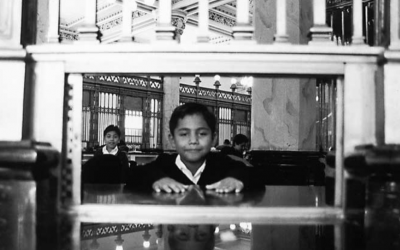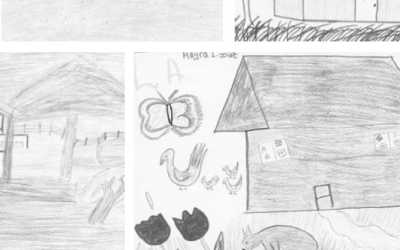Through the Eyes of Children
Barrio children help resolve ethical dilemmas in photography

Alán came for his portrait bringing three flowers and two cousins. Photo by Ellen Calmus.
Twenty years ago, I put my camera away, suspending a photographic career I’d happily pursued for nearly a decade. I did this after publishing photos I’d taken in a Salvadoran war zone in 1983 during a summer of research on land reform. These were not the kind of war photographs you might imagine putting a photographer off photography forever, not the gory images of hurt bodies that magazine editors think twice about publishing, but photographs of a farming community. The photo I recall as having most disturbed me at the time was a picture of a very small boy walking through a field carrying a curved machete. The caption was a quotation from the people of that Morazán farming community: “Our children start carrying the corvo at the age of three, so that they will get used to it.”
What was missing on the page disturbed me even more than the violence of the poverty depicted there: the role of my own government in the boy’s situation. At that time, community residents were in danger of dying of starvation because of the combined effects of a severe drought and a military blockade designed to weaken guerrilla presence in the area. Whether or not it was weakening the guerrillas, the strategy of cutting off supplies to this area—implemented by the Salvadoran army with the support and financing of the U.S. government—was starving the little boy with the corvo. Knowing this seemed to imply a responsibility for a citizen to do something about it. I felt an intense, if inarticulate, ethical discomfort about publishing these photos, these strangely attractive images of desperate people in brightly-colored scenic tropical settings, photos that did not manage to do anything at all in response to the tragedy I saw in them. My academic focus made me feel that it would be inappropriate to use them for an explicitly activist purpose. But my inaction felt like a betrayal of the people in those photos. As if in publishing them for an unconcerned readership I would be promoting the ugly phenomenon Susan Sontag refers to in Regarding the Pain of Others when she writes: “It is passivity that dulls feeling.”
My (unsatisfactory) way of dealing with this ethical dilemma was to request that the editor of the photography magazine publish along with the photos my accompanying text,“Why You Can’t Be a Photographer in El Salvador.” I heard not a ripple of the shocked reaction I’d expected in response to the combination of photographs and text. I couldn’t tell what readers had understood about the reality behind those pictures, but there was no sign that publishing them had accomplished anything more than filling those pages with colorful images. After that, I simply stopped being a photographer.
Ten years before I had been a Harvard Visual Studies major, inspired by the classes I took from a dynamic young teacher of documentary film and photography at Carpenter Center. Dick Rogers encouraged his students to consider the ethical as well as the aesthetic values expressed in our photography, and I was most impressed with the work he showed us by photographers like Dorothea Lange and Walker Evans. After graduation I went to work as a photographer and writer for an alternative magazine in Montana. Dick was enthusiastic when I showed him my clippings, which were very much in the vein of old-style investigative journalism: articles on working conditions in a mining town, on the suspicious jail death of a young Blackfeet Indian in a reservation town, on ecological scandals; with Dorothea Lange-inspired black and white portraits of Montana workers, small-town meter maids, Native Americans, farmers.
From Montana I went to Mexico, where I studied Spanish, photographed campesino theater groups and spent several years working with Cine Mujer, a Mexican feminist film group, making documentaries about issues like rape, abortion and women in the maquila industry. When I asked Dick if he would write a graduate school recommendation, he exclaimed, “Don’t tell me: you’re applying to medical school!” expressing a sort of amused dismay at how many of his former students were abandoning work in his field. I assured him that I was not applying to graduate school in order to change careers, but only because I was truly puzzled by how U.S. policy looked from outside the U.S. and wanted to understand it. He wrote me a lovely recommendation, but I suspect he saw me as another photographic casualty—which, in effect, I soon became after that summer of graduate school research in El Salvador.
In January 2001, El Salvador was hit by a series of devastating earthquakes. I returned there to work with a U.S. relief agency. On a cloudless morning a month after the first terrible quakes, as I was taking a taxi to the agency’s office, a second series of even more destructive earthquakes battered the country. The agency’s emergency director and I drove across the country to the worst-hit areas. We surveyed the destruction. The ground still trembled under our feet. He handed me his digital camera. My hands shook as I took pictures of a mountain smoking from landslides cascading down its sides, a student carrying a typewriter out of the rubble, a woman crying in front of the ruins of her home. I was surprised to find that the people I asked for permission to take their pictures always gave it, often thanking me for being there and seeming to find it a relief to talk. Though I felt terrible about being empty-handed except for the camera—for we’d gone out ahead of the agency’s trucks carrying relief supplies—I was struck by the fact that the survivors of this disaster seemed to feel a deep need for their experience to be witnessed by the outside world.
Suddenly photography started making sense to me again, especially when my photos went directly onto the relief agency’s website. When the agency such record levels of donations for earthquake relief efforts that it was now expanding existing recovery programs and initiating others, it seemed those photos on the website had probably helped. I found myself regaining my lost faith in photography’s potential to be a force for good.
On my way home to Malinalco, a small farming town in the mountains southwest of Mexico City, I bought a used digital camera, though it wasn’t clear to me what it would mean to do photography here. I showed it to the children who come to the neighborhood educational resource center I’ve been running for the past several years, where I help them with homework and tutor them in any problem areas—as their parents often can’t, not having had adequate educations themselves. The children and I do other things, too: art projects, games, singing, walks in the hills. The idea is to build self-esteem as well as strengthen their academic skills. The children immediately got excited about the camera and started telling me what pictures they wanted me to take.
That was the beginning of one of the most interesting photography projects I’ve ever done. I joked with friends that I was just the camera operator; it was the children who were the directors of photography. In fact, this was true. I found it fascinating to let them decide where they wanted me to take pictures and how they wanted to present themselves (for, not surprisingly, the pictures that interested them most were the ones of themselves). It seemed to me that the process produced a special quality in the expressions captured in these portraits: a self-assurance they normally display only among themselves, which tends to vanish in the presence of adults. While the fact that many of these photos are of smiling children might make them seem at first glance to be a rather polished variation on your basic adorable-Third-World-kids tourist pictures, I see something quite different and exciting in them, images which say “This is ME.”
I confess to enjoying the respite this process gave me from the need to justify taking pictures while I revived my long-dormant photographic skills. I was taking these photographs because the children wanted me to. That seemed to absolve me from any further need for justification. It was clear that the experience, along with the pictures they took home to their parents, constituted a major boost to the children’s self-esteem. I liked the Freireian aspects of this method of subject- generated photography, including the fact that letting them direct the process was bound to be as instructive for me as it was for them. Two of the children reported that their parents had had the small prints I’d given them blown up and framed. I started detecting a new tone in the notes the children sometimes leave for me in my mailbox (When one wrote: “I am very PROUD of you, Ellen,” I figured the wording was probably based on what her parents had said to her).
After I’d taken pictures of them in my yard, on the street, climbing the hill behind our barrio, leading a horse in from pasture, the children started bringing me their baby brothers, sisters, nephews and nieces to photograph, which in the natural course of things led to my photographing their adult relatives, as well—who, introduced to me by their own children, responded with enthusiasm. I began attending barrio processions and feast days, invariably finding that there would be children present who had studied with me or had come by to have their picture taken, who could introduce me to the adults I encountered, which made things more comfortable for us all. Eventually, the city of Malinalco agreed to mount an exhibit of these photos in the municipal cultural center, to be titled: ¡Que Viva El Rincón! Portraits of a Barrio.
There was considerable excitement about the exhibit in the barrio. I had decided to make it a benefit for the community project called “El Rincón” which was evolving from our educational resource center, and the people in the barrio were quick to add their support. A newly-formed women’s income-generating group made tamales to sell at the opening; a group of young women studying computer skills with me on a recently-donated computer did the organizing to handle sales; neighbors who worked at a local nursery donated roses and the local brass band offered to play for the event. Mothers brought their children, all dressed up for the occasion, to cut the ribbon, and when the band struck up the rousing tuba-heavy music that I call “oompah-ranchero,” the children danced.
In the following weeks, every time I passed the cultural center I’d see some local resident studying the photos in the exhibit, often with a market basket over an arm, usually accompanied by a child or two. People from the barrio who had never been in the cultural center before went to see the exhibit; people I’d never met would introduce themselves to me as the parent, uncle, aunt, or grandparent of a child in one of the photos, which would naturally lead to a conversation about the portrayed child and a feeling of mutual pride. When I asked a local shopkeeper what he’d thought of the exhibit, he said: “It was good. We needed something like this.”
Nothing could have surprised or gratified me more than hearing that my photography was needed. Though it is practically a cliché to say that art is necessary, in fact we continue to think of art as a luxury. When we think about the culture of the poor, we rarely think in terms of art appreciation. I believe that what the shopkeeper meant was that the exhibit proposed a barrio identity with which the residents of these sloping cobblestone streets could identify. But was this art? Certainly these photos have little in common with those of the Depression-era photographers whose work first inspired me. And it may be that these brightly-colored images of rather heroiclooking campesinos and their sassy but sensitive-looking children may strike some as being typified by that most damning of all adjectives (when applied to art, at least): sentimental—though I think that in the subject-generated photography of a population that has been oppressed for centuries, what might at first glance appear to be sentimental is actually something much more interesting.
If Dick Rogers were alive today, I’d want to continue our discussions about what art is and what it is for. Art or not, though, the children continue talking about these images, including their changing opinions about them and their ideas about other things they’d like to see in pictures. Meanwhile, young people who saw the exhibit continue showing up asking if they can take a class, or if Proyecto El Rincón could support a new community project. Municipal officials who saw the exhibit have given us the support requested for our projects. Without knowing what kind of aesthetic evaluation these photographs will receive from the world outside Malinalco, I find I’m satisfied with the ways in which they are useful both to the subjects themselves and to their community. I’ve found a direction for my photography that I can pursue with conviction.
Several of the children of El Rincón reviewed the photos I sent to June Carolyn Erlick for this issue of ReVista. They found it interesting to see themselves in black and white, but decided they like their pictures better in color. Anayeli confessed that she would prefer not to have a portrait we took together displayed in Malinalco, because it shows us wearing the famous locally-produced Mexican shawls called rebozos (“They’ll say we look like grannies!”) but said she wouldn’t mind it being published in a place as far away as Harvard. You can see color versions of some of these and other photos at
Winter 2004, Volume III, Number 2
Ellen Calmus graduated from Harvard in 1973 and received her MPA from the Woodrow Wilson School of Public and International Affairs at Princeton in 1986. She lives in Malinalco, Mexico, where she is writing a book about the Salvadoran war and coordinating Proyecto El Rincón, a barrio-based community project which includes an educational resource center and educational development projects for children, youths and adults.
Related Articles
Editor’s Letter: The Children
A blue whale spurts water joyfully into an Andean sky on my office door. A rainbow glitters among a feast of animals and palm trees. Geometrical lightning tosses tiny houses into the air with the force of a tropical hurricane.
Centroamerica
Cuando Pedro Pirir, fue despedido del taller mecánico donde trabajaba desde hacía muchos años, experimentó una sensación de injusticia y pena que luego se transformó en una voluntad…
Irregular Armed Forces and their Role in Politics and State Formation
As I sat in heavy traffic in the back of a police car during rush hour in the grimy northern zone of Rio de Janeiro, I studied the faces of drivers in neighboring cars, wondering what they thought of…




